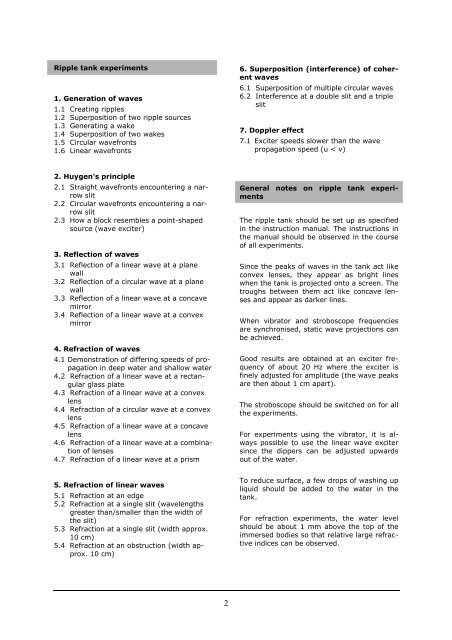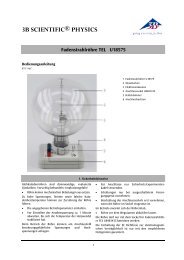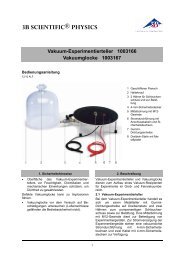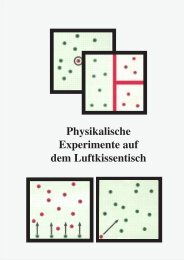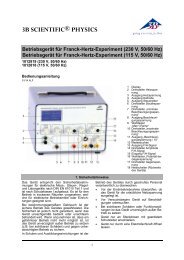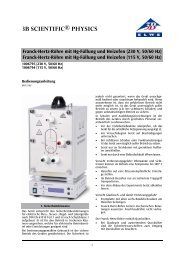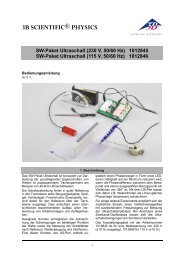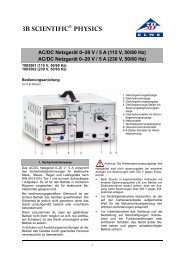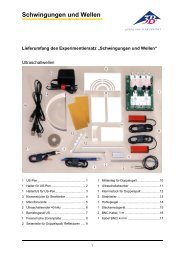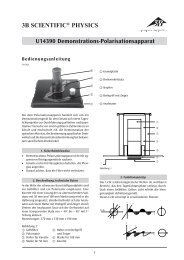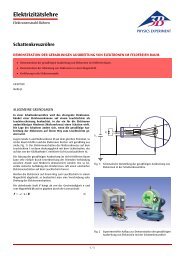3B SCIENTIFIC® PHYSICS Wellenwanne U21910
3B SCIENTIFIC® PHYSICS Wellenwanne U21910
3B SCIENTIFIC® PHYSICS Wellenwanne U21910
Create successful ePaper yourself
Turn your PDF publications into a flip-book with our unique Google optimized e-Paper software.
Ripple tank experiments<br />
1. Generation of waves<br />
1.1 Creating ripples<br />
1.2 Superposition of two ripple sources<br />
1.3 Generating a wake<br />
1.4 Superposition of two wakes<br />
1.5 Circular wavefronts<br />
1.6 Linear wavefronts<br />
6. Superposition (interference) of coherent<br />
waves<br />
6.1 Superposition of multiple circular waves<br />
6.2 Interference at a double slit and a triple<br />
slit<br />
7. Doppler effect<br />
7.1 Exciter speeds slower than the wave<br />
propagation speed (u < v)<br />
2. Huygen's principle<br />
2.1 Straight wavefronts encountering a narrow<br />
slit<br />
2.2 Circular wavefronts encountering a narrow<br />
slit<br />
2.3 How a block resembles a point-shaped<br />
source (wave exciter)<br />
3. Reflection of waves<br />
3.1 Reflection of a linear wave at a plane<br />
wall<br />
3.2 Reflection of a circular wave at a plane<br />
wall<br />
3.3 Reflection of a linear wave at a concave<br />
mirror<br />
3.4 Reflection of a linear wave at a convex<br />
mirror<br />
4. Refraction of waves<br />
4.1 Demonstration of differing speeds of propagation<br />
in deep water and shallow water<br />
4.2 Refraction of a linear wave at a rectangular<br />
glass plate<br />
4.3 Refraction of a linear wave at a convex<br />
lens<br />
4.4 Refraction of a circular wave at a convex<br />
lens<br />
4.5 Refraction of a linear wave at a concave<br />
lens<br />
4.6 Refraction of a linear wave at a combination<br />
of lenses<br />
4.7 Refraction of a linear wave at a prism<br />
General notes on ripple tank experiments<br />
The ripple tank should be set up as specified<br />
in the instruction manual. The instructions in<br />
the manual should be observed in the course<br />
of all experiments.<br />
Since the peaks of waves in the tank act like<br />
convex lenses, they appear as bright lines<br />
when the tank is projected onto a screen. The<br />
troughs between them act like concave lenses<br />
and appear as darker lines.<br />
When vibrator and stroboscope frequencies<br />
are synchronised, static wave projections can<br />
be achieved.<br />
Good results are obtained at an exciter frequency<br />
of about 20 Hz where the exciter is<br />
finely adjusted for amplitude (the wave peaks<br />
are then about 1 cm apart).<br />
The stroboscope should be switched on for all<br />
the experiments.<br />
For experiments using the vibrator, it is always<br />
possible to use the linear wave exciter<br />
since the dippers can be adjusted upwards<br />
out of the water.<br />
5. Refraction of linear waves<br />
5.1 Refraction at an edge<br />
5.2 Refraction at a single slit (wavelengths<br />
greater than/smaller than the width of<br />
the slit)<br />
5.3 Refraction at a single slit (width approx.<br />
10 cm)<br />
5.4 Refraction at an obstruction (width approx.<br />
10 cm)<br />
To reduce surface, a few drops of washing up<br />
liquid should be added to the water in the<br />
tank.<br />
For refraction experiments, the water level<br />
should be about 1 mm above the top of the<br />
immersed bodies so that relative large refractive<br />
indices can be observed.<br />
2


